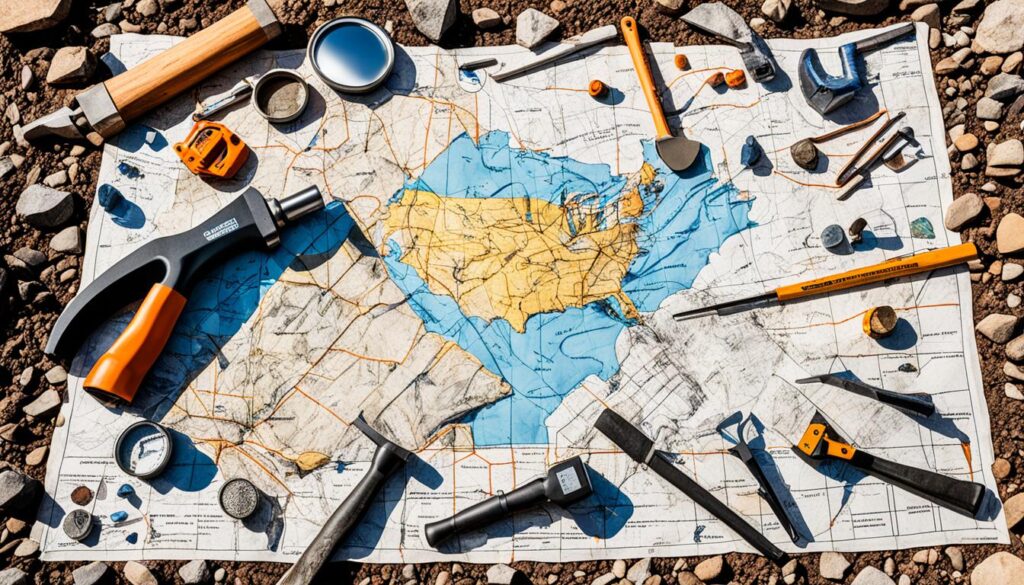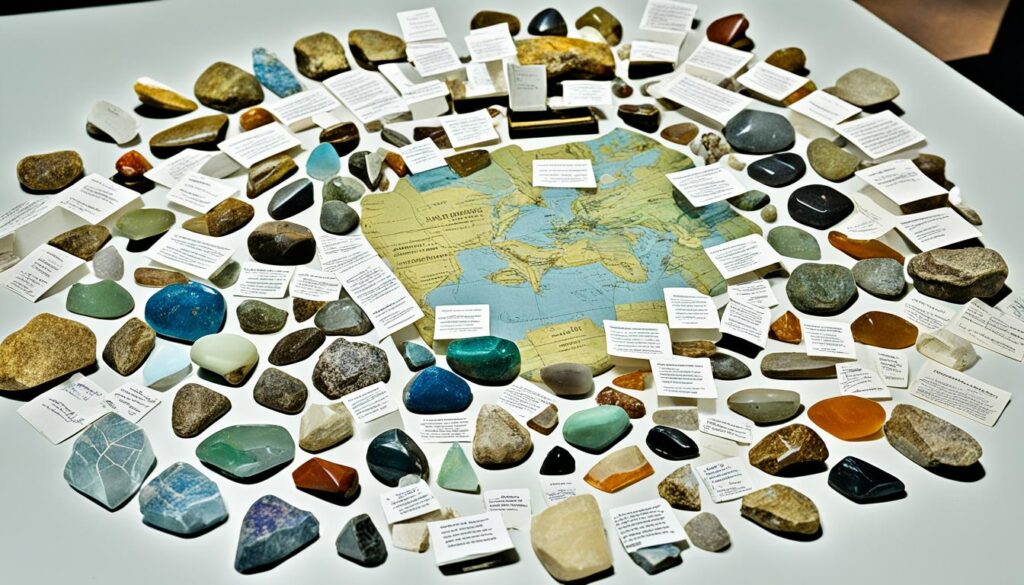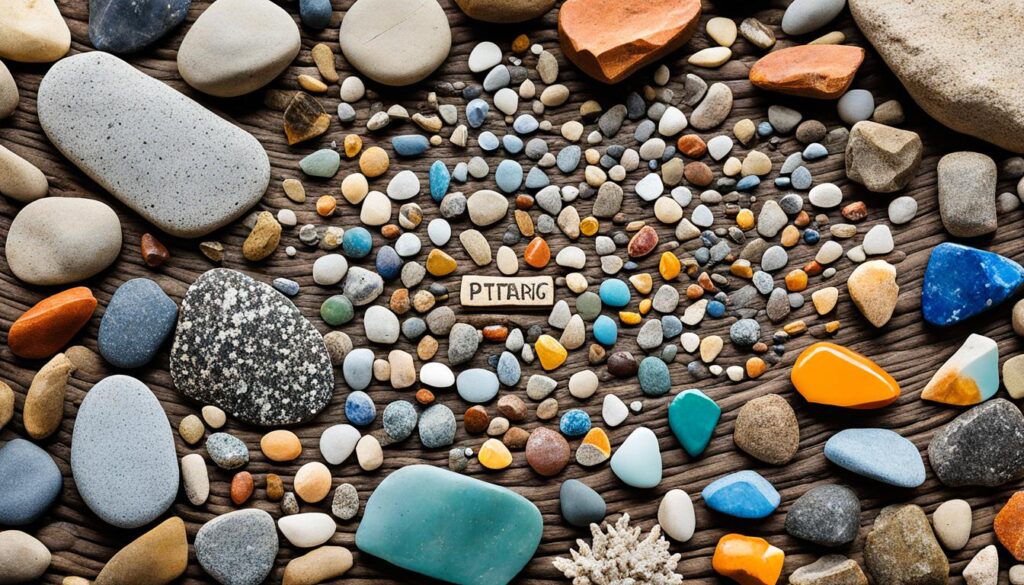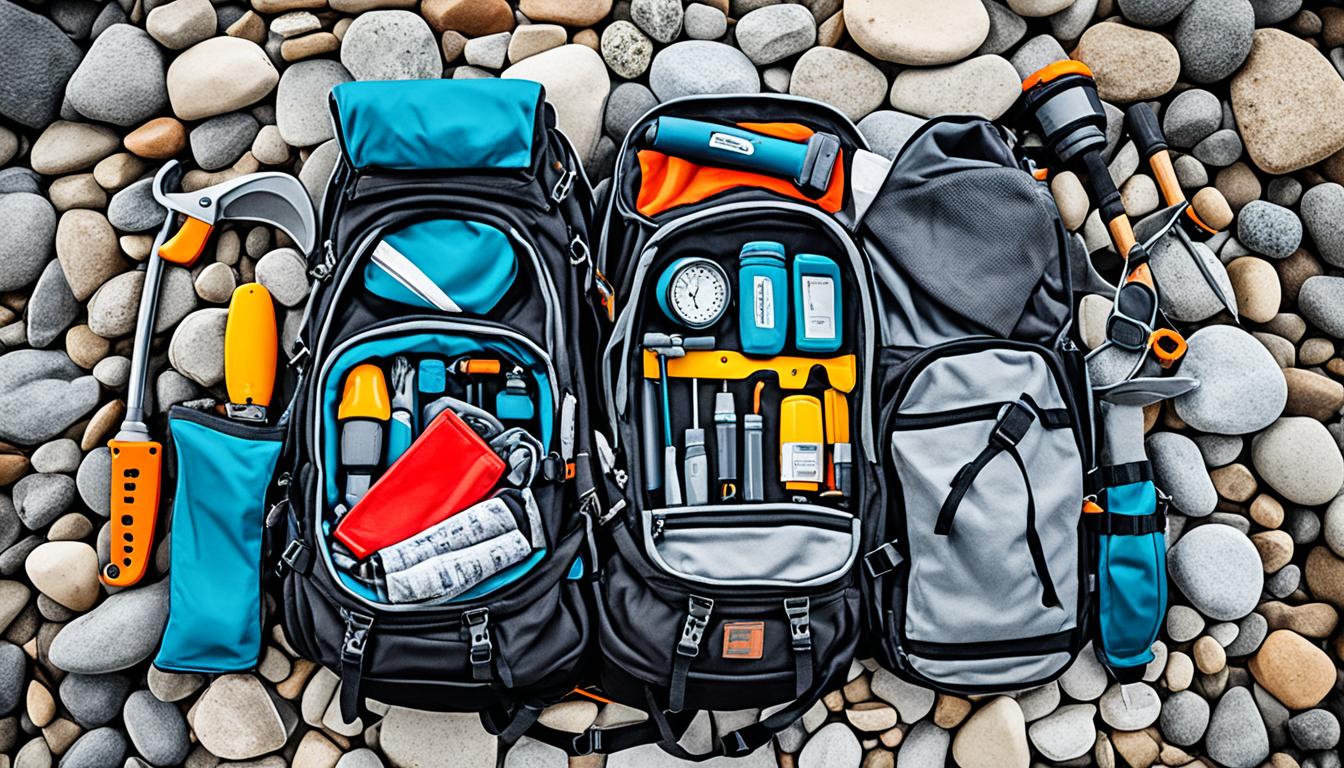This post contains affiliate links.
There’s something innately human about the desire to search and discover; it’s a compelling force that drives us out into the wilderness with eyes wide in anticipation. You’ve felt that tug, haven’t you? The promise of unearthing a hidden treasure from the folds of the earth is not just a call to adventure—it’s a siren’s song that entices the curious and ignites the passion of collectors. Whether you are embarking on your first rockhounding trip or you’re a seasoned collector, arm yourself with the right rockhounding equipment, tips for successful rockhounding trips, and a heart open to the surprises nature has tucked away. The allure of finding rocks and minerals is timeless, and with careful rockhounding trip planning, your next journey might just be the one that rewards you with a geological masterpiece.
Key Takeaways
- Equip yourself with essential rockhounding gear for safety and success.
- Undertake thorough trip planning to enhance your chances of discovery.
- Learn about local geology to know where to find rocks and minerals.
- Adopt environmentally respectful practices during your rockhounding adventures.
- Stay informed on legal guidelines for collecting in different areas.
- Incorporate patience and persistence as part of your rockhounding journey.
An Introduction to Rockhounding
Welcome to the captivating world of rockhounding, a hobby that seamlessly blends science with the great outdoors. Whether you’re seeking a peaceful retreat from the hustle of everyday life or looking to enrich your knowledge of the Earth’s geological wonders, rockhounding provides a path to both. Before diving into this engaging activity, let’s explore what it entails and discover why it continues to attract enthusiasts of all ages.
What is Rockhounding?
At its core, rockhounding is the art of searching for and collecting natural mineral specimens, including rocks, crystals, and gemstones. It’s a venture that demands patience, a keen eye, and a love for the unpredictable gifts of nature. To partake in rockhounding is to become a treasure hunter, each find a unique addition to your personal collection that tells a story of geological history and transformation.
Why Rockhounding Attracts Enthusiasts of All Ages
Rockhounding does not discriminate by age or background; it offers something for everyone. For children, it’s a magical treasure hunt; for adults, a relaxing pastime or a serious study of mineralogy. The appeal lies in the thrill of discovery, the beauty of the finds, and the invaluable hands-on education it provides. With helpful rockhounding techniques at your disposal and a few rockhounding tips for beginners, you’re well on your way to starting your own adventure.
| Benefit | Explanation |
|---|---|
| Educational Value | Learn about the earth’s geology through direct interaction with mineral specimens. |
| Recreational Activity | Combine the joy of outdoor exploration with the excitement of discovering hidden gems. |
| Environmental Appreciation | Develop a deeper connection with nature as you learn about and collect its materials. |
| Mental and Physical Wellness | Experience the therapeutic benefits of focusing on a task while engaging in physical activity outdoors. |
| Community Connection | Join a network of fellow rockhounds, sharing stories, tips, and finds. |
Ready to begin your journey into rockhounding? Remember, with the right approach and tools, every excursion promises the potential for extraordinary discoveries. Embrace your curiosity, respect the landscapes you explore, and prepare to be amazed by the gifts the earth has to offer.
Essential Rockhounding Equipment
Embarking on a rockhounding adventure means being well-equipped to handle the terrain and the task at hand. The rockhounding safety precautions you take can significantly impact the enjoyment and success of your trip. Part of this safety comes from having the right equipment. To help you preserve your rockhounding finds and ensure a safe experience, here’s a list of essential gear that should be a part of every rockhound’s toolkit.
- Safety Glasses: Protect your eyes from potential chips and debris.
- Rock Hammer or Geologist’s Pick: A fundamental tool for chipping away at rock formations and extracting samples.
- Mallet: Useful for gentle taps that can separate rocks without damaging them.
- Chisel: Works hand-in-hand with your mallet to pry specimens from their natural beds.
- Durable Bucket or Bag: Secure storage for transporting your finds.
- Protective Work Gloves: Shield your hands from sharp edges and rough surfaces.
- Sturdy Boots: Support and protect your feet while navigating rugged terrain.
As your experience in the field grows, your gear might evolve with specialized tools. However, these staples will set a solid foundation for any rockhounding expedition.
Remember to always handle your equipment responsibly and respect the natural environment. By doing so, you’ll not only enjoy a safer rockhounding journey but also ensure that the sites you visit remain pristine for future enthusiasts. Happy hunting and always aim to leave the area as undisturbed as possible, preserving the joy of discovery for all.
Pre-Trip Research: Maximizing Your Rockhounding Potential
Embarking on a rockhounding journey isn’t just about heading outdoors with your gear; it begins with thorough pre-trip research. By arming yourself with knowledge about what to look for and where to look, you lay the groundwork for a fulfilling hunting experience. This research is particularly valuable for beginners eager to absorb rockhounding tips for beginners and master the art of finding rocks and minerals.
Understanding Your Local Geology
Recognizing the geological backdrop of your intended destination can dramatically increase your chances of unearthing unique specimens. You’ll want to understand the rock types, soil layers, and mineral deposits that define your local landscape, as each environment hosts a distinct set of treasures waiting to be discovered.
Utilizing Online Resources and Libraries for Research
Today’s rockhound has an array of resources at their fingertips. Online geological surveys, databases, and academic papers provide a wealth of information about various locations and the kinds of minerals that inhabit them. Similarly, local libraries can serve as a treasure trove of regional geology books and maps that might lead you to your next exciting find.
The Importance of Joining Local Mineral Collector’s Clubs
As a beginner, getting involved with a local mineral collector’s club can be a game-changer. You’ll find yourself surrounded by seasoned collectors who share your passion and are frequently keen to pass on invaluable rockhounding tips for beginners. These clubs often organize group excursions, allowing you to learn hands-on in the field.
- Networking with experienced rockhounds
- Access to exclusive field trips and collecting sites
- Illustrative educational sessions and workshops
The American Mineral Federation, for instance, can connect you with a vibrant community of collectors and deepen your understanding of finding rocks and minerals.
| Club Benefits | Beginners | Experienced Collectors |
|---|---|---|
| Field Trip Access | Guided learning experiences | Expanded collection opportunities |
| Networking Opportunities | Connection with mentors | Sharing expertise and finds |
| Educational Resources | Workshops and literature | Advanced seminars |
| Trading and Swap Meets | Building initial collections | Diversifying and specializing collections |
Rockhounding Safety Precautions
When setting off on a rockhounding adventure to some of the best rockhounding locations around the country, it’s important that you prioritize your well-being with the necessary rockhounding safety precautions. Venturing out to uncover Earth’s natural treasures can be both exciting and unpredictable, but with the right preparation, you can ensure a safer experience.
Proper Attire for Field Expeditions
Your clothing choice is your first line of defense against the elements and unforeseen hazards during your expeditions. Investing in high-quality, weather-appropriate attire can make a world of difference:
- Dress in layers to accommodate temperature changes throughout the day.
- Select moisture-wicking fabrics to keep dry and comfortable.
- Choose long sleeves and pants to protect against scratches and insect bites.
- Don’t forget a hat and UV-protective sunglasses to shield from sun exposure.
Navigating Terrain and Weather Conditions
Understanding and adapting to varying terrains is vital to maintaining your safety:
- Study topographical maps and plan your route accordingly.
- Check the weather forecast and be prepared for sudden changes.
- Carry a compass or GPS device to aid in navigation.
- Always inform someone of your plans and expected return time.
| Terrain Type | Recommended Gear | Precautions |
|---|---|---|
| Rugged Trails | Sturdy hiking boots, walking stick | Be wary of loose stones and uneven ground |
| Water Bodies | Waterproof boots, life vest | Monitor water levels and currents |
| Sandy Areas | Closed-toe sandals, sunshade | Stay hydrated and watch for quicksand |
| Mountainous Regions | Specialized climbing gear | Understand rock stability and slope grade |
Remember, the key to a rewarding rockhounding experience is to balance your eagerness to explore with mindfulness towards safety and preservation. By doing so, you’ll not only protect yourself but also ensure that the natural beauty of these sites remains unspoiled for fellow enthusiasts and future generations.
Best Rockhounding Locations
Embarking on a rockhounding adventure can lead you to some breathtaking and geologically diverse locales. As you set out to uncover nature’s treasures, it’s essential to prioritize known best rockhounding locations that not only offer a variety of specimens but also adhere to the legalities of rock collection. Here’s a glimpse into spots that should top your list and some rock identification tips to enhance your experience.
| Location | Known For | Collection Rules | Identification Tips |
|---|---|---|---|
| Michigan’s Petoskey State Park | Petoskey Stones | Permit required; quantity limits | Look for hexagonal patterns, often best seen when wet |
| California’s Jade Cove | Jade | Hand tools only; subject to daily limits | Check for waxy luster and smoothness |
| Arkansas’ Crater of Diamonds State Park | Diamonds, quartz crystals | Finders keepers policy | Use a screen to sift through soil; look for the tell-tale shine |
| North Carolina’s Emerald Hollow Mine | Emeralds, hiddenite, quartz | Fee-based collecting | Examine for green hues characteristic of emeralds |
While some locations immediately reveal their geological gifts, others may require a practiced eye and patience for rock identification. It’s advisable to consult field guides specific to the region you’re exploring, and don’t hesitate to ask locals or fellow rockhounds for first-hand insights. Keep in mind the importance of environmental stewardship; collect responsibly, and never take more than you need.
Whether you’re a seasoned collector or a novice attracted to the joys of rockhounding, understanding the features of the best rockhounding locations and employing strategic rock identification tips will surely make your next outing both enjoyable and fruitful. Nature awaits—happy hunting!
Rockhounding Techniques for Finding the Best Specimens
Unlocking the secrets of the earth and uncovering the most stunning geological treasures hinges on mastering the right rockhounding techniques. Whether it’s your inaugural dig or you’re seasoned in the field, there’s always more to unearth about the best practices for successful prospecting.
Effective Searching Strategies
To heighten your chances of success during your expeditions, strategic planning is key. Your patience and attention to detail could lead you to a truly magnificent find. For example, the hunting for Petoskey stones along lakeshores is significantly enhanced when the sun is high, illuminating their unique patterns and making them more distinguishable against the wet sand.
Tools for Extracting and Collecting Specimens
Being equipped with the appropriate tools not only makes your search more effective but also preserves the quality of your collected specimens. A well-chosen rock hammer and sturdy chisel are indispensable companions in gently prying sought-after rocks from their locations. Below is an overview of essential tools that should be part of any rockhound’s toolkit.
| Tool | Use | Specimen Type |
|---|---|---|
| Rock Hammer | Breaking rocks | General |
| Chisel | Extraction and splitting | Layered minerals |
| Sieve | Sifting through debris | Small stones/gems |
| Geologist’s Pick | Precise breaking and carving | Embedded specimens |
| Magnifying Glass | Detailed examination | Tiny crystals/fossils |
| GPS or Map | Locating and marking sites | All types |
For those just beginning their rockhounding adventure, incorporating these rockhounding tips for beginners into your approach can be transformational. Skilled use of these tools allows you to methodically collect samples without damaging their natural state—keeping the integrity of your finds pristine for future admiration and study.

Tips for Successful Rockhounding Trips
Success in rockhounding is largely dependent on your preparation before you hit the great outdoors. Rockhounding trip planning is more than just marking a map; it includes in-depth research on types of rocks and minerals and the localities where they can be found. Be thorough in equipping yourself with the necessary tools, and never compromise on rockhounding safety precautions.
When you’re packing for your adventure, comfort is paramount. Look for clothing and footwear that will stand up to demanding terrains and shield you from unpredictable weather. Your patience will be tested as you search—often for hours—for that one perfect specimen. But remember, respect for the natural environment contributes to both ethical rockhounding and the longevity of this hobby for others to enjoy.
Moreover, being part of a community that shares your passion for rockhounding can be profoundly beneficial. Engaging with clubs and groups offers opportunities to exchange knowledge, get tips on the best spots for rockhounding, and learn from others’ experiences.
Embrace patience, respect the environment, and immerse yourself in the rockhounding community for a fulfilling experience.
| Rockhounding Must-Haves | Safety Precautions | Community Engagement |
|---|---|---|
| Geologist’s hammer | Sturdy gloves and boots | Join local rockhounding clubs |
| Collection bag or bucket | Eye protection | Participate in field trips |
| Field guidebooks | Weather-appropriate clothing | Share experiences online |
| Navigation tools | First-aid kit | Attend rock and mineral shows |
- Research potential rockhounding sites ahead of time.
- Dress appropriately for terrain and climate conditions.
- Always carry your rockhounding equipment.
- Take necessary safety precautions seriously.
- Patience is key—good finds may take time.
- Engage with a community to enhance your rockhounding journey.
Maintaining and Documenting Your Rock Collection
As a dedicated rockhound, the joy of your adventure extends to the care and management of your treasured collections. Keeping a detailed record and preserving your rockhounding finds are essential for both personal enjoyment and educational purposes.
How to Catalog Your Finds
It is critical to catalog each rock and mineral you’ve collected, ensuring that all details are meticulously recorded. Start by assigning a unique identifier to every item, this might include an entry number or a code that references your specific system.
- Item Number: Assign a sequential number or specific code for easy reference.
- Mineral Name: Record the full mineralogical name of each specimen.
- Varietal Information: Note any varietal names that apply to your finds.
- Date and Location: Detail the date of collection and the exact location where it was found.
- Description: Include a brief description or notable characteristics.

Preserving the Integrity of Your Specimens
Caring for your rock and mineral specimens is a complex task. Utilize rockhounding equipment designed for cleaning and maintenance to ensure that your collection remains well-preserved. Here’s a guide to maintaining the integrity of your specimens:
| Cleaning Method | Type of Specimens | Tools and Solutions |
|---|---|---|
| Water Rinse | Non-soluble crystals and stones | Distilled water, soft brushes |
| Mechanical Cleaning | Geodes and clustered minerals | Chisels, dental picks, small hammers |
| Chemical Bath | Rusted or iron-coated specimens | Mild acids like white vinegar, protective gear |
| Ultrasonic Cleaner | Fragile or intricate specimens | Ultrasonic cleaning machines, mild detergent |
In addition to the methods above, be sure to store your collection in a controlled environment away from direct sunlight and extreme temperatures, which could damage sensitive rocks and minerals. Remember to handle each piece with care, using the right rockhounding equipment to minimize physical wear. By faithfully preserving rockhounding finds and keeping detailed documentation, you ensure that each piece of your collection tells its own unique story for years to come.
Identifying Your Rockhounding Finds
Embark on the thrilling aspect of your rockhounding hobby: identifying the treasures you’ve unearthed. With the right rock identification tips, the process becomes a detective’s adventure, deciphering clues hidden in the colors, patterns, and textures of each stone. Your avid search for finding rocks and minerals culminates in this moment, requiring careful observation and a bit of geological knowledge.
While high-tech nature apps fall short for rock identification, traditional methods stand the test of time. Guidebooks and field guides act as your trusted sidekicks, turning uncertainties into discoveries. Here’s a fundamental table to start your identification journey:
| Color | Luster | Hardness | Streak |
|---|---|---|---|
| Often the first observable feature, but can be misleading without other context. | The way a mineral reflects light. Can be metallic, glassy, or dull, among others. | Measures resistance to scratching, a key identification factor. | The color of the mineral in powdered form, typically tested on a streak plate. |
Remember, connecting with experienced rockhounds and geo-enthusiasts enhances your identification skills. So, when in doubt, reach out to knowledgeable individuals or institutions that can lend you a hand in identifying your rockhounding finds.
Conclusion
Embarking on a rockhounding journey merges the excitement of discovery with the serenity of nature. This hobby offers a pathway to understanding the world beneath our feet and the story of our planet.
Reviewing the Best Practices for Rockhounding
To secure many rewarding rockhounding trips, it’s essential to engage in thorough rockhounding trip planning. Success is not a matter of chance; it’s about preparation, knowledge, and the application of field-smart techniques. Remember to always check the latest regulations of your intended rockhounding site and gear up with the proper safety equipment. Use the collective wisdom from seasoned rockhounds and clubs to refine your approach and avoid common pitfalls.
The Rewarding Experience of Rockhounding
The allure of rockhounding is undeniable. It goes beyond the physical treasures; it’s about the profound connection with earth’s history and the joy of the hunt. Follow these tips for successful rockhounding trips to ensure each outing is as fulfilling as the treasures you seek. Whether solo or with a community of fellow enthusiasts, the rewards of rockhounding await.

Beneath your feet lies a hidden world of riches waiting to be uncovered. With a little bit of guidance, the right tools, and a mindful approach, you’re well on your way to becoming a successful rockhound. Celebrate each find, no matter how small, for it represents a fragment of a much larger geological narrative—one that you are now a part of.
| Type | Description | Location Tips |
|---|---|---|
| Quartz | Hard, crystalline mineral | Look for veins in rocky outcrops |
| Feldspar | Most abundant group of minerals in the earth’s crust | Common in granite formations |
| Mica | Silicate mineral with a layered structure | Found in pegmatites and schists |
| Petoskey Stone | Fossilized coral with distinct patterns | Beaches and lake shores in Northern Michigan |
May your journeys be filled with discovery, education, and a deeper respect for the earth’s wonders. Remember, the best part of rockhounding is not just what you find, but the memories you create while searching for the hidden beauty of nature.
Get Involved and Share Your Passion for Rockhounding
Rockhounding transcends the mere act of collecting minerals; it’s a practice enriched by the communal knowledge and enthusiasm of its participants. For those at the start of their rockhounding journey, the importance of connecting with local mineral collector’s clubs cannot be overstated. These clubs provide not just camaraderie but also serve as hubs for learning, offering plentiful rockhounding tips for beginners. They’re the meeting grounds where experienced collectors inspire and educate novices, helping you to navigate this rewarding hobby with greater confidence.
By participating in club-organized events and field trips, your rockhounding exploits become endeavors shared with peers who can offer practical advice, from the best hammer techniques to navigating legalities during collection. Engaging with others in this shared pursuit offers a chance to expand your understanding and skills, all while forming lasting bonds with fellow rock enthusiasts. Remember, your individual progress contributes to the vibrancy of the entire rockhounding community; every story, every piece of advice, and every question asked adds to its collective richness.
Your experiences and insights are a valuable contribution to the growing body of rockhounding knowledge. Whether you are finding your first mineral specimen or facilitating an expert-led geological workshop, you become part of a tradition that values education, mentorship, and fellowship. Sharing your passion isn’t just about displaying your latest finds; it’s about nurturing a space where the next generation of rockhounds can discover the joys of this unique and engaging hobby. So step forward, engage generously with your peers, and let your rockhounding adventure be one that not only enhances your life but also enriches the collective experience of the community you join.
FAQ
What basic equipment do I need for rockhounding?
How can I get started with rockhounding?
Where are the best places to go rockhounding?
How do I ensure my safety while rockhounding?
How do I identify the rocks and minerals I find?
What are some efficient rockhounding techniques?
How should I prepare for a rockhounding trip?
What are the benefits of joining a local mineral collector’s club?
How do I maintain and document my rock collection?
Why do I need to know my local geology before rockhounding?
What should I consider when choosing rockhounding locations?
How can I preserve the integrity of my rockhounding finds?
Source Links
- https://queeradventurers.com/rockhounding-michigan/
- https://www.irocks.com/rock-and-mineral-collecting-for-beginners
- https://howtofindrocks.com/how-to-start-rockhounding/
This post contains affiliate links.


[…] your quest begins with the essential question: where to find rocks for rockhounding? Through this rockhounding guide, we aim to set you on a path lined with geological wonders to fuel your thirst for discovery. […]